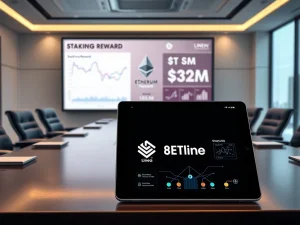Visa Stablecoin Strategy: Revolutionizing Cross-Border Payments to a Staggering $250 Billion Market

The financial world is buzzing with anticipation as Visa, a titan in the global payments industry, makes a significant strategic move. Their focus? Leveraging Visa stablecoin technology to fundamentally reshape how money moves across borders. This isn’t just a minor adjustment; it’s a calculated leap into the future of finance, promising to unlock unprecedented efficiency and reach for businesses and individuals worldwide.
Visa Stablecoin Strategy: A Game-Changer for Global Payments
Visa’s bold pivot towards stablecoins is set to revolutionize global payments, particularly in emerging markets where traditional banking infrastructure often lags. Executives like Cuy Sheffield, Visa’s head of crypto, have championed stablecoins as a solution to long-standing inefficiencies. In 2025 alone, the Visa Tokenized Assets Program (VTAP) processed an impressive $225 million in cross-border payments, a clear indicator of the strategy’s tangible impact and active deployment.
This strategic shift aims to reduce reliance on costly intermediaries and complex currency conversions, which often inflate costs and delay settlements. Visa’s approach is deliberate and pragmatic, building on successful pilot programs, such as the 2023 settlement trials with USDC. Richard Meszaros, another key executive, highlighted the ‘significant opportunity for cross-border payments’ that stablecoins present, especially in regions battling conventional system bottlenecks. This proactive stance underscores Visa’s commitment to evolving its core services with cutting-edge blockchain technology.
Unlocking Efficiency: How Cross-Border Payments Are Being Transformed
The traditional landscape of cross-border payments is ripe for disruption. Visa’s integration of stablecoins offers several compelling advantages that directly address the pain points of legacy systems:
- Speed: Near-instant settlements, bypassing lengthy banking hours and processing times. This means money moves in minutes, not days.
- Cost Efficiency: Minimizing foreign transaction fees and intermediary charges. Lower costs translate to more value for senders and recipients.
- Accessibility: Providing financial services to underserved populations in emerging markets, bridging the gap for those without traditional bank accounts.
- Transparency: Leveraging blockchain’s immutable ledger for clearer, verifiable transaction trails, enhancing trust and accountability.
By focusing on disbursement services and international commerce, Visa is positioning stablecoins as a powerful tool to bypass legacy systems. This is particularly critical for users in underdeveloped financial ecosystems, where traditional banking can be slow, expensive, or simply unavailable, making stablecoins a vital lifeline for economic participation.
The Exploding Stablecoin Market: A $250 Billion Opportunity
Visa’s strategic timing aligns perfectly with the rapid expansion of the stablecoin market, which reportedly surged to a staggering $250 billion in 2025. This remarkable growth underscores the increasing confidence in stablecoins as a reliable bridge between fiat currencies and the digital asset world. Unlike volatile cryptocurrencies, stablecoins are designed to maintain a stable value, typically pegged to a fiat currency like the US dollar, making them ideal for transaction and settlement purposes.
This inherent stability is a key factor in their appeal to institutional players like Visa, who prioritize reliability and regulatory alignment. The company’s focus on remittances and international settlements, rather than speculative retail transactions, reflects a calculated move to capitalize on sectors with high unmet demand and a clear use case for stable, digital value transfer within this burgeoning stablecoin market.
Driving Digital Payments: Visa’s Pragmatic Approach
Visa’s strategy for digital payments through stablecoins is rooted in practicality, not speculation. Godfrey Sullivan, a senior executive, has emphasized the urgent need for a robust stablecoin strategy by 2025. This proactive stance contrasts sharply with the speculative narratives often associated with decentralized finance (DeFi), treating stablecoins as a pragmatic innovation rather than a disruptive threat to existing systems.
By embedding stablecoins within its established infrastructure, Visa effectively mitigates compliance risks while aligning with broader institutional trends that favor stablecoins for their fiat-backed stability. This measured approach positions Visa as a bridge between legacy financial systems and the next generation of finance, balancing cutting-edge innovation with meticulous risk management. This focus on practical applications is crucial for driving widespread adoption of digital payments.
Empowering Global Remittances: The Human Impact
One of the most profound impacts of Visa’s stablecoin initiative is its potential to transform remittances. For millions globally, sending money home to family across borders can be a costly and time-consuming ordeal. Stablecoins offer a lifeline, promising faster, cheaper, and more transparent transfers. This is particularly vital in emerging markets, where a significant portion of the population relies on remittances for their livelihoods.
The ability to offer near-instant settlements with minimal fees can drastically improve the financial well-being of families worldwide. This human-centric aspect underscores the broader societal benefits of integrating stablecoins into established payment networks, moving beyond mere technological advancement to tangible improvements in people’s lives and fostering greater financial inclusion.
Challenges and the Road Ahead
Despite the immense potential, challenges remain. Standardized regulations and interoperability across various platforms are crucial for widespread adoption. Visa’s emphasis on emerging markets is both strategic and practical, as these regions often present higher barriers to traditional financial services, making stablecoins a viable alternative for cross-border flows.
The company’s track record in payment innovation, coupled with its established global network, suggests it is well-positioned to capture a significant share of the growing demand for cross-border solutions. While analyst forecasts for specific market shares are still nascent, the opportunity for Visa to lead in this evolving sector is undeniable, balancing innovation with the ongoing need for regulatory clarity.
Conclusion: Visa Forging the Future of Global Payments
Visa’s strategic embrace of stablecoins marks a pivotal moment in the evolution of global finance. By leveraging this technology, the payments giant is not just enhancing its services but actively shaping the future of cross-border payments, making them faster, cheaper, and more accessible for millions worldwide. With $225 million in processed transactions and a rapidly expanding stablecoin market, Visa is demonstrating that innovation can seamlessly integrate with established systems, paving the way for a more efficient and inclusive global economy. This bold move solidifies Visa’s position at the forefront of the digital payment revolution, promising a future where global money movement is as effortless as a local transaction.
Frequently Asked Questions (FAQs)
- What is Visa’s stablecoin strategy?
Visa’s stablecoin strategy focuses on leveraging stablecoins, such as USDC, to revolutionize cross-border payments, particularly in emerging markets. The goal is to provide faster, lower-cost, and more efficient solutions for international transactions and remittances, avoiding disruption to domestic retail systems. - How much did Visa process in stablecoin transactions in 2025?
In 2025, Visa processed $225 million in cross-border transactions via its Visa Tokenized Assets Program (VTAP), utilizing stablecoins as part of its strategic initiative. - Why is Visa focusing on emerging markets for stablecoin adoption?
Visa is focusing on emerging markets because these regions often face significant bottlenecks and higher costs with traditional banking infrastructure. Stablecoins offer a viable alternative for these areas, providing near-instant settlements and minimal foreign transaction fees, which are critical for users in underserved financial ecosystems. - What are the main benefits of using stablecoins for cross-border payments?
The primary benefits include near-instant settlements, significantly reduced transaction costs and fees, increased accessibility for the unbanked, and enhanced transparency through blockchain’s immutable ledger. - What challenges does Visa face in implementing its stablecoin strategy?
Key challenges include the need for standardized global regulations for stablecoins and ensuring interoperability across various blockchain platforms. Navigating these complexities is crucial for widespread adoption and scalability. - How does Visa’s approach to stablecoins differ from speculative DeFi?
Visa’s approach is pragmatic and focused on practical applications for cross-border payments and remittances, treating stablecoins as a stable, fiat-backed tool for efficiency. This contrasts with the often speculative and volatile nature of many decentralized finance (DeFi) applications.









